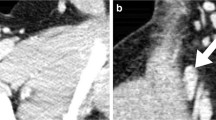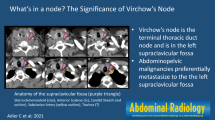Abstract
Purpose
The purpose of this study was to establish normative data for the CT appearance of inguinal lymph nodes.
Materials and methods
After Institutional Review Board approval, search of the radiology information system identified 500 consecutive CT examinations of the pelvis. Patients were included if no lower extremity or perineum pathology, or history of malignancy at the time of CT examination, and a clinical note documenting no tumor at least 2 years after the CT. The final study group was 77 patients. CT examinations were retrospectively reviewed and bilateral inguinal lymph nodes were characterized by size (short axis and largest size in general), number, and presence of fat attenuation.
Results
The mean short-axis inguinal lymph node size was 5.4 mm (range 2.1–13.6 mm), measured at 8.8 mm two standard deviations above the mean. The mean number of superficial and deep inguinal lymph nodes was 10.7 (range 3–18) and 1.2 per patient (range 1–2), respectively. Superficial and deep inguinal nodes showed internal fat attenuation in 85 and 78 % of nodes, and were oval in shape in 95 and 78 %, respectively.
Conclusion
Inguinal lymph nodes in asymptomatic patients have a mean short axis of 5.4 mm, a short axis of 8.8 mm at two standard deviations above the mean, and are multiple and symmetric in size and number (4–20 per patient). Normal inguinal lymph nodes were commonly oval in shape and contained fat, although such findings may be absent in smaller lymph nodes.



Similar content being viewed by others
References
Abang Mohammed DK, Uberoi R, de B Lopes A, Monaghan JM (2000) Inguinal node status by ultrasound in vulva cancer. Gynecol Oncol 77(1):93–96
Bipat S, Fransen GA, Spijkerboer AM, van der Velden J, Bossuyt PM, Zwinderman AH, Stoker J (2006) Is there a role for magnetic resonance imaging in the evaluation of inguinal lymph node metastases in patients with vulva carcinoma? Gynecol Oncol 103(3):1001–1006
de Carvalho JP, Patricio BF, Medeiros J, Sampaio FJ, Favorito LA (2011) Anatomic aspects of inguinal lymph nodes applied to lymphadenectomy in penile cancer. Adv Urol 2011:952532. doi:10.1155/2011/952532
Esen G (2006) Ultrasound of superficial lymph nodes. Eur J Radiol 58(3):345–359
Glazer GM, Gross BH, Quint LE, Francis IR, Bookstein FL, Orringer MB (1985) Normal mediastinal lymph nodes: number and size according to American Thoracic Society mapping. AJR 144(2):261–265
Grey AC, Carrington BM, Hulse PA, Swindell R, Yates W (2000) Magnetic resonance appearance of normal inguinal nodes. Clin Radiol 55(2):124–130
Grubnic S, Vinnicombe SJ, Norman AR, Husband JE (2002) MR evaluation of normal retroperitoneal and pelvic lymph nodes. Clin Radiol 57(3):193–200. Discussion 201–194
Jackson AS, Sohaib SA, Staffurth JN, Huddart RA, Parker CC, Horwich A, Dearnaley DP (2006) Distribution of lymph nodes in men with prostatic adenocarcinoma and lymphadenopathy at presentation: a retrospective radiological review and implications for prostate and pelvis radiotherapy. Clin Oncol R Coll Radiol 18(2):109–116
Obwegeser R, Lorenz K, Hohlagschwandtner M, Czerwenka K, Schneider B, Kubista E (2000) Axillary lymph nodes in breast cancer: is size related to metastatic involvement? World J Surg 24(5):546–550
Singh K, Orakwue CO, Honest H, Balogun M, Lopez C, Luesley DM (2006) Accuracy of magnetic resonance imaging of inguinofemoral lymph nodes in vulval cancer. Int J Gynecol Cancer 16(3):1179–1183
Solivetti FM, Elia F, Graceffa D, Di Carlo A (2012) Ultrasound morphology of inguinal lymph nodes may not herald an associated pathology. J Exp Clin Cancer Res 31(1):88. doi:10.1186/1756-9966-31-88
Vinnicombe SJ, Norman AR, Nicolson V, Husband JE (1995) Normal pelvic lymph nodes: evaluation with CT after bipedal lymphangiography. Radiology 194(2):349–355
Conflict of interest
None of the authors have any relevant interests to disclose.
Author information
Authors and Affiliations
Corresponding author
Rights and permissions
About this article
Cite this article
Bontumasi, N., Jacobson, J.A., Caoili, E. et al. Inguinal lymph nodes: size, number, and other characteristics in asymptomatic patients by CT. Surg Radiol Anat 36, 1051–1055 (2014). https://doi.org/10.1007/s00276-014-1255-0
Received:
Accepted:
Published:
Issue Date:
DOI: https://doi.org/10.1007/s00276-014-1255-0




